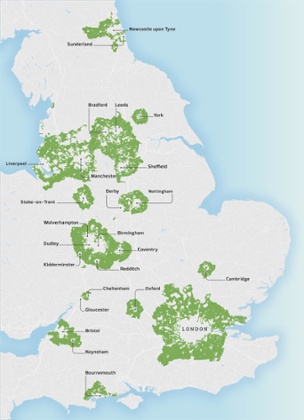| |
 Posted Oct 22, 2014, 11:52 PM
Posted Oct 22, 2014, 11:52 PM
|
 |
Registered User
|
|
Join Date: Aug 2002
Location: Toronto
Posts: 52,200
|
|
|
Is it time to rethink Britain's green belt?
Is it time to rethink Britain's green belt?
18 October 2014
 Read More: http://www.theguardian.com/politics/...the-green-belt
Read More: http://www.theguardian.com/politics/...the-green-belt
Quote:
.....
London is indeed surrounded by a green belt, as are 13 other urban areas in England and 10 in Scotland, zones that forbid new development, except, as the policy wording has it, in “very special circumstances”. They occupy 13% the total land area of England, compared with the 10% that is urbanised.
- Almost anyone you talk to on the subject agrees that the green belt is one of the great successes of planning, anywhere in the world. It has prevented the interminable exurbia, the light smearing of development over landscape that you get in the United States and many other countries.
- But it also has costs. It stops cities expanding, which had previously done so for centuries. It contributes to the scarcity and cost of decent homes in large parts of the country. It encourages bizarre and wasteful patterns of commuting. It often fails in its original aim of providing accessible recreational space for city dwellers. It is enforced with a rigidity that makes little sense, except as a sign of mistrust.
- It would be naive to think that the country’s housing problems would solved just by handing tracts of the green belt to developers. Something more is required, which is the ability to plan positively, to create new places as well as protect old ones, a skill this country had until relatively recently.
- It is not a small thing to rediscover this art, but then neither is the green belt, nor the current issues of housing. The green belt arouses strong passions, but the debates around it are about something still larger, which is the ability of a country to act together in a shared endeavour, or to subdivide into competing interests.
- The libertarian thinktank the Adam Smith Institute has argued that, if a strip merely half a mile wide were shaved off the London green belt, 800,000 new homes could be built. Defenders of the green belts, such as the Campaign to Protect Rural England (CPRE), are accused of ignoring “those who are marginalised and condemned to poor housing”.
- The London Society, the group to which Aston Webb told his dream and which was instrumental in creating the green belt, has commissioned research from the commercial real estate company Colliers International, which says that we “need to move away from the idea that the countryside is a sacrosanct patchwork of medieval hedgerows” and towards the recognition of “housing as a need to be met in locations with appropriate environmental capacity”.
- A particularly vocal critic, Professor Paul Cheshire of the London School of Economics, has written that “the unstoppable damage they do to societal fairness, housing affordability, the economic efficiency of our cities, even the environment, is devastating”. He argues that new houses in Britain are 40% more expensive than the Netherlands, which is more densely populated, and that the green belt is at least partly to blame.
- It is said that green belts are not fulfilling their original aims of providing recreation for city dwellers. Dwellers of Toxteth or Hackney are not especially likely to make the journey to their nearest green belts, rather than Sefton or Victoria Park, or to countryside further afield. Rather, says Cheshire, the idea has been “used as a form of exclusionary zoning by the more affluent residents who had got there already”.
- It is a device, in this view, for rich dwellers of green belts, who enjoy proximity to both cities and countryside, to stop anyone else sharing their idyll. He argues that green belts force commuters to live outside them, and jump over them daily, some travelling from as far away as Norwich to work in London.
- Paul Cheshire questions the environmental quality of the intensive agriculture that is the largest single use of green belt land, and cites the National Ecosystem Assessment of 2011 as saying that such land “has no environmental benefits at all”. Suburban gardens contribute much more biodiversity. It is argued, finally, that other designations, such as areas of outstanding natural beauty, national parks and sites of special scientific interest do some of the job of protecting what is really important about the countryside, which makes green belts less vital.
.....
|
England’s green belts. Graphic by Pete Guest for the Observer New Review
 Urbed’s snowflake-shaped concept for a garden city which it applied to Oxford. Photograph: PR
Urbed’s snowflake-shaped concept for a garden city which it applied to Oxford. Photograph: PR

__________________
ASDFGHJK
|
|
|



